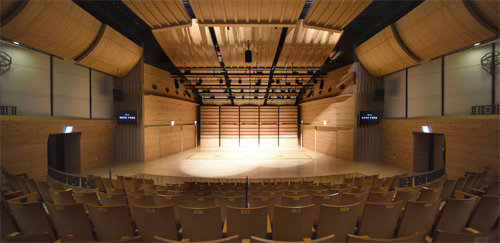National Gugak Center’s Woomyeondang Theater reopens
National Gugak Center’s Woomyeondang Theater reopens
Posted February. 09, 2017 07:04,
Updated February. 09, 2017 07:10

Orchestral music of sanjo (free style solo) ensemble, which was staged at a press meeting ahead of the reopening of the National Gugak Center’s Woomyeondang Theater on Wednesday, was an event that heralded silent revolution in the gugak (Korean traditional music) community. It was ‘natural sound’ without the use of microphones, but echo of each and every musical instrument was sufficiently presented to exude a stately mood. Light whipping sound of the janggu (Korean double-headed drum), which was placed at the far rear row, was also heard vividly, loud and clear.
The Woomyeondang Gugak Theater, which reopens on February 15 after remodeling work that took nine months to complete, boasts the largest scale among the natural sound music halls for gugak performance that have been constructed so far. The Pungnyu Sarangbang and the Donhawmun Gugak Theater are also acoustic sound music halls, but they are relatively small in size, which makes it difficult to present ensemble performance by an intermediate size or larger group.
A natural acoustic musical hall has been a long-cherished dream in the gugak community in that the facility allows concertgoers to hear inherent natural sound of gugak instrument. Diverse acoustic tools have been introduced to fill the 231-seat Woomyeondang Theater only with natural sound. Ten resonators have been installed underneath the front of the stage to magnify the echoes of string instrument that offers relatively smaller volume. In addition, 24 acoustic reflectors have been placed on the ceiling and the walls surrounding the stage to ensure the sound spreads evenly. Acoustic reflectors that are movable to the front and the rear depending on the size of the performing group have also been erected at the rear of the stage. Extra sound insulating facilities have also been installed to block noise, and the gradient of the spectators’ stand has been reduced from 22 degrees to 16 degrees to increase the sense of stability.
“Only when exercise of chamber music performance is done adequately, then can the performing skills for orchestral music get solid and robust,” said Kim Hae-sook, the head of the National Gugak Center. “The Woomyeondang will make major contributions to elevating the level of chamber music performing skills in the gugak community.”
Sang-Un Kim sukim@donga.com







